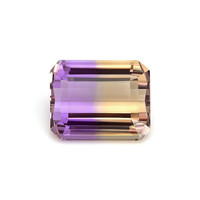Treatments and Enhancements of Ametrine
Unveiling the Art: Treatments and Enhancements of Ametrine

Ametrine, with its natural allure of purple and golden hues, stands as a testament to nature’s artistry. However, like many gemstones, ametrine can undergo various treatments and enhancements to accentuate its beauty, improve clarity, or even modify its colors. Understanding these processes is crucial for collectors, jewelers, and enthusiasts alike, as it impacts the gemstone’s value, authenticity, and care requirements. This blog delves into the common treatments and enhancements applied to ametrine, offering insight into how these processes can transform and elevate this already stunning gemstone.
Natural vs. Treated Ametrine: The Initial Distinction
Ametrine, a blend of amethyst and citrine, is rare in its natural form. Most high-quality ametrines come from the Anahí Mine in Bolivia, known for producing stones with distinct and vibrant color zoning. While natural ametrines are highly valued for their untouched beauty, some stones undergo treatments to enhance their appearance. Distinguishing between natural and treated ametrine is vital for valuation and for those who prefer gems in their untouched state.
Heat Treatment: Enhancing Color Contrast
One of the most common treatments for ametrine is heat treatment, a practice shared with many other quartz varieties. This process involves heating the gemstone to alter its color — enhancing the contrast between the purple and yellow zones or improving the saturation of each color. Heat treatment is generally stable and can make certain ametrines more visually appealing by creating a more striking distinction between its dual hues. It’s important to note that heat treatment is permanent and does not require any special care for the treated gemstone.
Irradiation: Intensifying Depth of Color
Irradiation is another treatment method that can be used to deepen the color of ametrine. This process can enhance the depth of the purple in amethyst zones or intensify the golden hue of the citrine parts. Irradiation, often followed by heat treatment, can dramatically affect the gemstone’s color intensity, producing results that might not occur naturally. As with heat treatment, irradiation effects are considered permanent, and irradiated ametrine does not require special maintenance.
Synthetic and Simulated Ametrine
In addition to treatments, there are synthetic and simulated ametrines on the market. Synthetic ametrines are lab-grown and possess the same chemical and physical properties as their natural counterparts but without the natural inclusions or color zoning variations. Simulated ametrines, on the other hand, are made from glass or other materials and merely mimic the appearance of ametrines. Both synthetic and simulated stones offer affordable alternatives to natural ametrine but lack the unique characteristics and value of the natural stone.
Disclosure and Ethics

Transparency about the treatment and enhancement processes a gemstone has undergone is crucial within the gem and jewelry industry. Reputable dealers will always disclose any treatments applied to their gemstones, allowing consumers to make informed decisions based on their preferences and values. Ethical considerations also play a role, as treatments can affect a gemstone’s value and its environmental and ethical footprint.
A Spectrum of Beauty
Treatments and enhancements have the power to bring out the best in ametrine, accentuating its dual colors, improving clarity, and sometimes even introducing entirely new aspects to its appearance. Whether choosing a natural, treated, or synthetic ametrine, understanding these processes allows for a deeper appreciation of the stone’s beauty and the craftsmanship involved in its presentation. In the end, whether treated or untouched, ametrine remains a captivating gem, celebrated for its unique color combination and the intriguing possibilities it represents in the world of gemology and jewelry design.
Please visit the link for more details about 4Cs Work Together in Ametrine!
